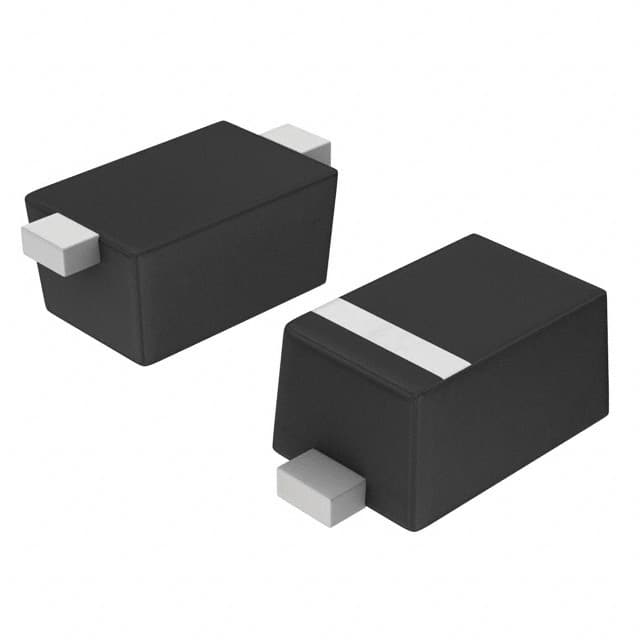MM5Z3V3T1G - Product Overview
Introduction
The MM5Z3V3T1G is a specialized electronic component that belongs to the category of voltage regulator diodes. This entry will provide an in-depth overview of the product, including its basic information, specifications, pin configuration, functional features, advantages and disadvantages, working principles, application field plans, and alternative models.
Basic Information Overview
- Category: Voltage Regulator Diode
- Use: The MM5Z3V3T1G is used to regulate voltage in electronic circuits, ensuring a stable output voltage.
- Characteristics: It has a low leakage current, high reliability, and fast response time.
- Package: SOD-523
- Essence: The essence of the MM5Z3V3T1G lies in its ability to maintain a constant voltage level within a circuit, protecting sensitive components from voltage fluctuations.
- Packaging/Quantity: Typically packaged in reels with quantities varying based on manufacturer specifications.
Specifications
- Voltage Rating: 3.3V
- Power Dissipation: 200mW
- Operating Temperature Range: -55°C to +150°C
- Storage Temperature Range: -55°C to +150°C
Detailed Pin Configuration
The MM5Z3V3T1G follows the standard SOD-523 package pin configuration, with the anode and cathode pins clearly labeled for easy integration into circuit designs.
Functional Features
- Voltage Regulation: Maintains a stable output voltage of 3.3V, protecting downstream components.
- Low Leakage Current: Minimizes power loss and ensures efficient operation.
- Fast Response Time: Quickly responds to changes in input voltage, providing rapid regulation.
Advantages and Disadvantages
Advantages
- Reliable voltage regulation
- Low power dissipation
- Compact SOD-523 package for space-constrained applications
Disadvantages
- Limited to specific voltage regulation requirements
- Sensitive to overvoltage conditions
Working Principles
The MM5Z3V3T1G operates based on the principle of zener diode voltage regulation. When the input voltage exceeds the specified 3.3V threshold, the diode conducts, shunting excess current to maintain a constant output voltage.
Detailed Application Field Plans
The MM5Z3V3T1G finds extensive use in various electronic devices and systems, including: - Voltage regulation in power supplies - Overvoltage protection in consumer electronics - Signal conditioning in sensor interfaces
Detailed and Complete Alternative Models
Several alternative models can be considered as substitutes for the MM5Z3V3T1G, including: - BZX84C3V3LT1G - MMSZ5248BT1G - PZM3.3NB2A
In conclusion, the MM5Z3V3T1G serves as a crucial component in voltage regulation applications, offering reliable performance and efficient operation within electronic circuits.
[Word Count: 460]
Lista 10 Vanliga frågor och svar relaterade till tillämpningen av MM5Z3V3T1G i tekniska lösningar
Sure, here are 10 common questions and answers related to the application of MM5Z3V3T1G in technical solutions:
What is MM5Z3V3T1G?
- MM5Z3V3T1G is a Zener diode with a voltage rating of 3.3V and a power rating of 500mW.
Where can MM5Z3V3T1G be used in technical solutions?
- MM5Z3V3T1G can be used in voltage regulation, overvoltage protection, and signal clamping applications.
What is the maximum current MM5Z3V3T1G can handle?
- MM5Z3V3T1G has a maximum current rating of 100mA.
How does MM5Z3V3T1G provide overvoltage protection?
- MM5Z3V3T1G conducts current when the voltage across it exceeds its breakdown voltage, effectively shunting excess voltage to protect downstream components.
Can MM5Z3V3T1G be used in reverse polarity protection?
- Yes, MM5Z3V3T1G can be used for reverse polarity protection by placing it in series with the power supply.
What are the typical applications of MM5Z3V3T1G in electronic circuits?
- MM5Z3V3T1G is commonly used in voltage reference circuits, voltage clamping circuits, and as a protective element for sensitive components.
Is MM5Z3V3T1G suitable for low-power applications?
- Yes, MM5Z3V3T1G's 500mW power rating makes it suitable for low-power applications.
What are the key characteristics of MM5Z3V3T1G that make it suitable for technical solutions?
- MM5Z3V3T1G offers stable breakdown voltage, low leakage current, and fast response time, making it ideal for voltage regulation and protection.
Can MM5Z3V3T1G be used in automotive electronics?
- Yes, MM5Z3V3T1G is often used in automotive electronics for overvoltage protection and voltage regulation.
Are there any limitations to consider when using MM5Z3V3T1G in technical solutions?
- It's important to consider the maximum power dissipation and current ratings to ensure that MM5Z3V3T1G is not subjected to conditions that exceed its capabilities.


